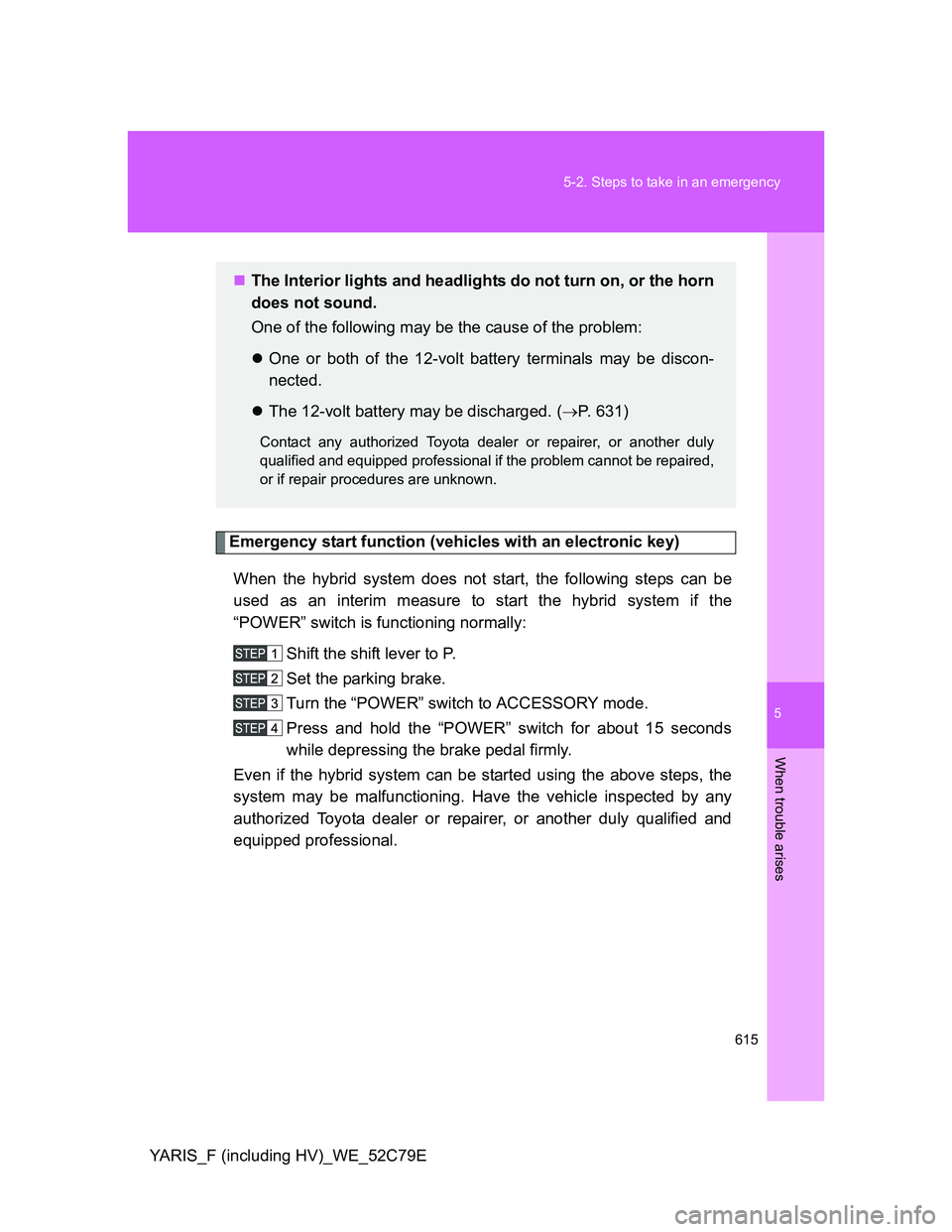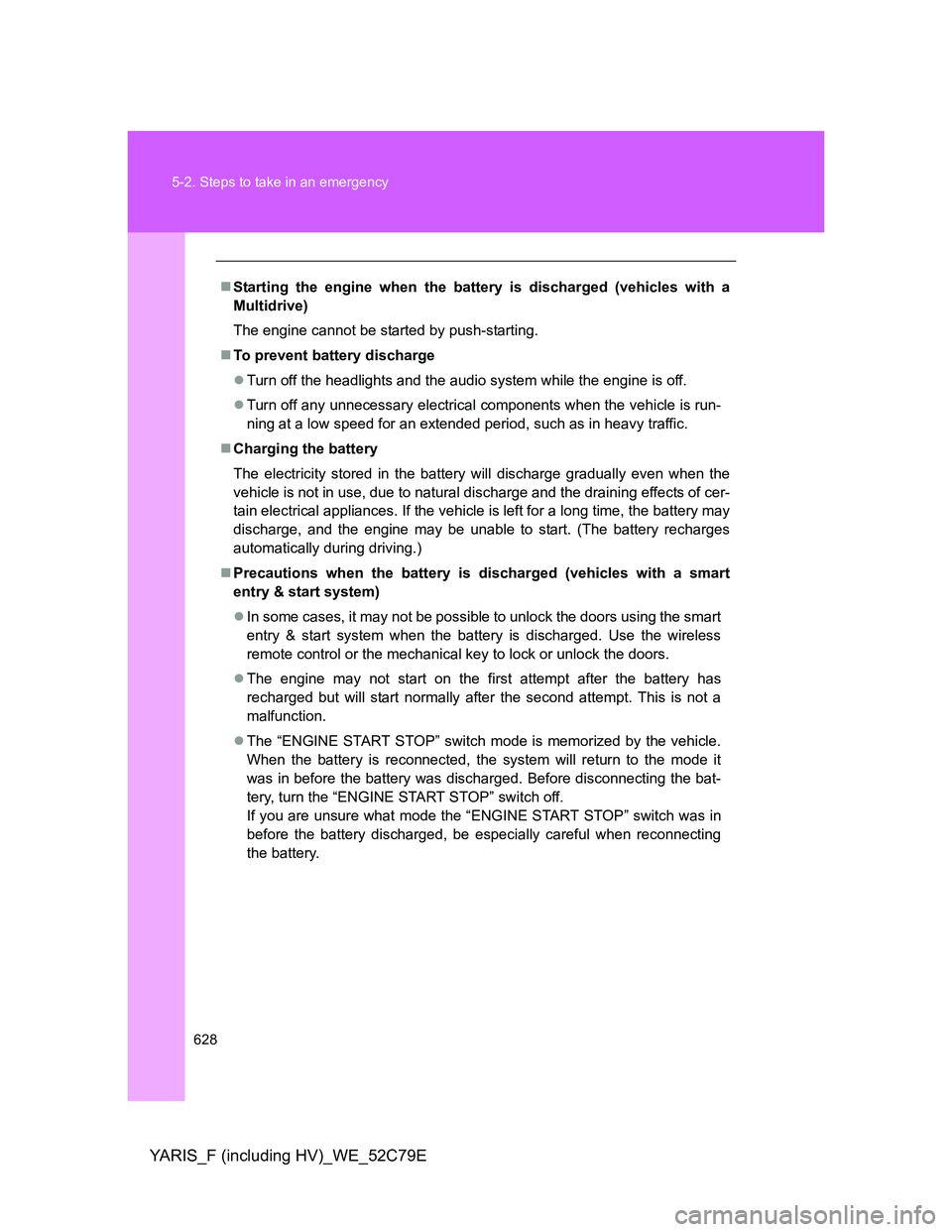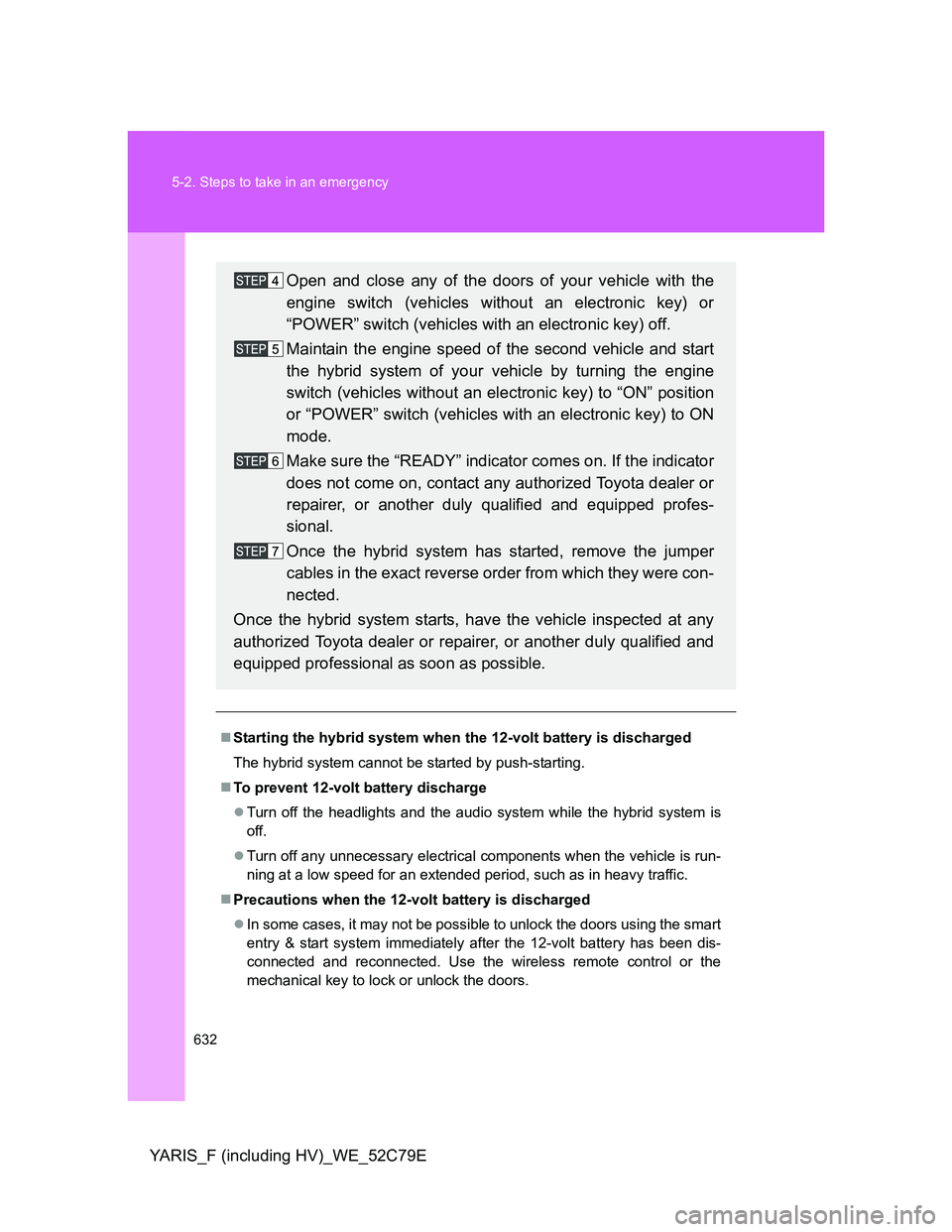Page 614 of 704

614
5-2. Steps to take in an emergency
YARIS_F (including HV)_WE_52C79E
If the hybrid system will not start (hybrid vehicle)
Reasons for the hybrid system not starting vary depending on the
situation. Check the following and perform the appropriate proce-
dure:
The hybrid system will not start even though the correct
starting procedure is being followed. (P. 238, 243)
One of the following may be the cause of the problem:
Vehicles with an electronic key: The electronic key may not be
functioning properly. (P. 619)
There may not be sufficient fuel in the vehicle’s tank.
Refuel the vehicle. (P. 151)
There may be a malfunction in the immobilizer system.
(P. 155)
There may be a malfunction in the steering lock system.
The hybrid system may be malfunctioning due to an electrical
problem such as an open circuit or a blown fuse. However,
depending on the type of malfunction, an interim measure is
available to start the hybrid system. (P. 615)
The interior lights and headlights are dim, or the horn does
not sound or sounds at a low volume.
One of the following may be the cause of the problem:
The 12-volt battery may be discharged. (P. 631)
The 12-volt battery terminal connections may be loose or cor-
roded.
Page 615 of 704

5
615 5-2. Steps to take in an emergency
When trouble arises
YARIS_F (including HV)_WE_52C79E
Emergency start function (vehicles with an electronic key)
When the hybrid system does not start, the following steps can be
used as an interim measure to start the hybrid system if the
“POWER” switch is functioning normally:
Shift the shift lever to P.
Set the parking brake.
Turn the “POWER” switch to ACCESSORY mode.
Press and hold the “POWER” switch for about 15 seconds
while depressing the brake pedal firmly.
Even if the hybrid system can be started using the above steps, the
system may be malfunctioning. Have the vehicle inspected by any
authorized Toyota dealer or repairer, or another duly qualified and
equipped professional.
The Interior lights and headlights do not turn on, or the horn
does not sound.
One of the following may be the cause of the problem:
One or both of the 12-volt battery terminals may be discon-
nected.
The 12-volt battery may be discharged. (P. 631)
Contact any authorized Toyota dealer or repairer, or another duly
qualified and equipped professional if the problem cannot be repaired,
or if repair procedures are unknown.
Page 628 of 704

628 5-2. Steps to take in an emergency
YARIS_F (including HV)_WE_52C79E
Starting the engine when the battery is discharged (vehicles with a
Multidrive)
The engine cannot be started by push-starting.
To prevent battery discharge
Turn off the headlights and the audio system while the engine is off.
Turn off any unnecessary electrical components when the vehicle is run-
ning at a low speed for an extended period, such as in heavy traffic.
Charging the battery
The electricity stored in the battery will discharge gradually even when the
vehicle is not in use, due to natural discharge and the draining effects of cer-
tain electrical appliances. If the vehicle is left for a long time, the battery may
discharge, and the engine may be unable to start. (The battery recharges
automatically during driving.)
Precautions when the battery is discharged (vehicles with a smart
entry & start system)
In some cases, it may not be possible to unlock the doors using the smart
entry & start system when the battery is discharged. Use the wireless
remote control or the mechanical key to lock or unlock the doors.
The engine may not start on the first attempt after the battery has
recharged but will start normally after the second attempt. This is not a
malfunction.
The “ENGINE START STOP” switch mode is memorized by the vehicle.
When the battery is reconnected, the system will return to the mode it
was in before the battery was discharged. Before disconnecting the bat-
tery, turn the “ENGINE START STOP” switch off.
If you are unsure what mode the “ENGINE START STOP” switch was in
before the battery discharged, be especially careful when reconnecting
the battery.
Page 632 of 704

632 5-2. Steps to take in an emergency
YARIS_F (including HV)_WE_52C79E
Starting the hybrid system when the 12-volt battery is discharged
The hybrid system cannot be started by push-starting.
To prevent 12-volt battery discharge
Turn off the headlights and the audio system while the hybrid system is
off.
Turn off any unnecessary electrical components when the vehicle is run-
ning at a low speed for an extended period, such as in heavy traffic.
Precautions when the 12-volt battery is discharged
In some cases, it may not be possible to unlock the doors using the smart
entry & start system immediately after the 12-volt battery has been dis-
connected and reconnected. Use the wireless remote control or the
mechanical key to lock or unlock the doors.
Open and close any of the doors of your vehicle with the
engine switch (vehicles without an electronic key) or
“POWER” switch (vehicles with an electronic key) off.
Maintain the engine speed of the second vehicle and start
the hybrid system of your vehicle by turning the engine
switch (vehicles without an electronic key) to “ON” position
or “POWER” switch (vehicles with an electronic key) to ON
mode.
Make sure the “READY” indicator comes on. If the indicator
does not come on, contact any authorized Toyota dealer or
repairer, or another duly qualified and equipped profes-
sional.
Once the hybrid system has started, remove the jumper
cables in the exact reverse order from which they were con-
nected.
Once the hybrid system starts, have the vehicle inspected at any
authorized Toyota dealer or repairer, or another duly qualified and
equipped professional as soon as possible.
Page 668 of 704
668 6-1. Specifications
YARIS_F (including HV)_WE_52C79E
Ignition system (gasoline engine only)
Electrical system
Spark plug
Make
Gap1KR-FE engine
DENSO SK16HR11
1NR-FE engine
DENSO SC20HR11
1NZ-FXE engine
DENSO FK16R-A8
1KR-FE and 1NR-FE engines
1.1 mm (0.043 in.)
1NZ-FXE engine
0.8 mm (0.031 in.)
NOTICE
Iridium-tipped spark plugs
Use only iridium-tipped spark plugs. Do not adjust the spark plug gap.
Battery (except hybrid vehicle)/
12-volt battery (hybrid vehicle)
Open voltage* at
20C (68F):12.6 12.8 V Fully charged
12.2 12.4 V Half charged
11 . 8 12.0 V Discharged
(
*: Voltage checked 20 minutes after
the engine and all the lights turned
off)
Charging rates 5 A max.
Page 677 of 704
677 6-1. Specifications
6
Vehicle specifications
YARIS_F (including HV)_WE_52C79E
Light bulbs
Except hybrid vehicle
A: H4 halogen bulbs B: H16 halogen bulbs
C: Wedge base bulbs (clear) D: Wedge base bulbs (amber)
E: Double end bulbs F: Single end bulbs (amber)
G: Single end bulbs (clear) H: H11 halogen bulbs
*: Replace the bulb with one of the same bulb as the original.
Light BulbsWTy p e
ExteriorHeadlights 60/55 A
Front fog lights (if equipped)
Type A
*
Type B*
19
55B
H
Front position lights 5 C
Front turn signal lights 21 F
Side turn signal lights 5 D
Back-up lights 16 C
Rear fog light 21 G
Stop/tail lights 21/5 G
License plate lights 5 C
Rear turn signal lights 21 F
InteriorVanity lights (if equipped) 5 E
Personal lights/interior light 5 C
Luggage compartment light 5 E
Page 678 of 704
678 6-1. Specifications
YARIS_F (including HV)_WE_52C79EHybrid vehicle
A: HIR2 halogen bulbs B: H16 halogen bulbs
C: Wedge base bulbs (clear) D: Wedge base bulbs (amber)
E: Double end bulbs F: Single end bulbs (amber)
G: Single end bulbs (clear)
Light BulbsWTy p e
ExteriorHeadlights 55 A
Front fog lights (if equipped) 19 B
Front turn signal lights 21 F
Side turn signal lights 5 D
Back-up lights 16 C
Rear fog light 21 G
License plate lights 5 C
Rear turn signal lights 21 F
InteriorVanity lights (if equipped) 5 E
Personal lights/interior light 5 C
Luggage compartment light 5 E
Page 683 of 704
683 6-2. Customization
6
Vehicle specifications
YARIS_F (including HV)_WE_52C79E
Smart entry &
start system
(
P. 69)Number of permissi-
ble times of continu-
ous smart lock
(hybrid vehicle)Twice Unlimited — O
Push-button
start system
(
P. 94)Push-button start
systemON OFF — O
Wireless
remote control
(
P. 105)Wireless
remote control
(hybrid vehicle)ON OFF — O
Operation signal
(Emergency flashers)ON OFF — O
Time elapsed before
automatic door lock
function is activated
if door is not opened
after being unlocked30 seconds60 seconds
—O
120
seconds
Automatic
light control
system
(P. 293)Light sensor sensi-
tivityLevel 3 Level 1 to 5 O O
Lights
(
P. 293)Daytime running
light system
(if equipped)ON OFF O O
Time that the low
beam headlights are
on when the vehicle
is parked30 seconds60 seconds
—O 90 seconds
120
seconds
ItemFunctionDefault
settingCustomized
setting